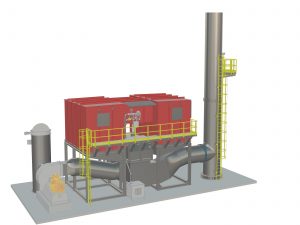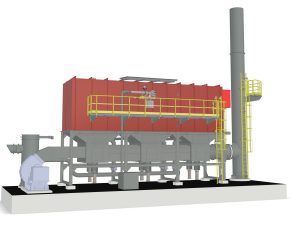- 1 Operating principles and different types of regenerative thermal oxidizers
- 2 Critical issues within the process of regenerative thermal oxidizers
- 3 Thermal oxidizer, how to optimize the efficiency?
- 4 Oxidation chamber: differences between two and three thermal chambers
- 5 How to choose between a 3-chamber and 2-chamber regenerative thermal combustor?
It is always very useful to investigate the advantages and disadvantages of different air treatment systems, however, there are significant design and construction variations even within the same technology. In this article we will present some important differences, in terms of operation and efficiency, regarding regenerative thermal oxidation plants.
Operating principles and different types of regenerative thermal oxidizers
Regenerative Thermal Oxidizers plants (RTO) are equipped with heat exchangers made of ceramic material, that allow a high thermal efficiency thanks to their capability to quickly accumulate and release the heat. This result is accomplished through two different procedures: the purification process (oxidation of S.O.V. to CO2 and H20 in a combustion chamber brought to 750-800 °C) and the energy recovery system based on heat recycling (accumulation and cyclic use in special “tanks” that we will call “chambers”).
Based on the number of chambers, there are two main categories of regenerative thermal plants, here enlisted in descending order of abatement efficiency:
- 3-chamber system
- 2-chamber system
In this article we provide some essential information to guide the users through the choice of the number of chambers to be installed for their RTO abatement system. We will focus, in particular, on the comparison between systems built with the same design principles, but different number of rooms.
Critical issues within the process of regenerative thermal oxidizers
It should be noted that the efficiency of oxidation, i.e. abatement, of volatile organic compounds in the combustion chamber is not affected by the number of chambers.
The efficiency of the system is rather linked to the actual oxidation reaction and, in particular, to the cyclic purification process.
In fact, whenever a flow reversal occurs within the VOC abatement plant (meaning the air flow that needs purifying changes direction), it is possible that a volume of not perfectly purified air is sent to the stack. The reasons for this may be the following:
- At time “t1” air is entering chamber 1 and exiting chamber 2. When we reverse the flow to better exploit the thermal energy stored in the chambers, we will switch the valves so that at time “t2” air is entering chamber 2 and exiting chamber 1. In this transitional phase, since we cannot interrupt the flow of air coming from production, there will be a period (generally a few seconds) during which both the inlet and the outlet valves in each tower will remain open (or partially open) until they have reached their new position. This way we have a by-pass of the plant as the air – as soon as it enters a chamber – prefers to take the exit route (which does not present any obstacles/load losses) rather than crossing all the filling bodies to reach the combustion chamber where the purification process takes place. As a result, we will find a high concentration of pollutants in the stack;
- Once the correct position of the valves has been restored, the air flow will go back through the system to be purified in the combustion chamber. However, there will still be a certain volume of air, which at time “t1” was warming up and going towards the combustion chamber, that was at a lower temperature and could not be purified. At time “t2” flow direction will change again and this air will be pushed towards the stack together with the purified air coming from above (combustion chamber), thus worsening the purification efficiency.
Thermal oxidizer, how to optimize the efficiency?
The purification efficiency of an RTO regenerative thermal oxidation plant depends on several factors, such as:
- valves tightness
- contact time
- correct mixing
- proper plant maintenance
As mentioned above, in this article we will compare RTO plants built with the same design principles but different number of chambers.
Oxidation chamber: differences between two and three thermal chambers
Two-chamber system
 This plant will most likely present all the problems outlined above. The concentration at the stack will therefore have a peak trend: at each flow inversion there will be a peak which will be directly proportional to the inlet concentration.
This plant will most likely present all the problems outlined above. The concentration at the stack will therefore have a peak trend: at each flow inversion there will be a peak which will be directly proportional to the inlet concentration.
Therefore, the concentration at the stack that can be guaranteed is closely related to the inlet one.
To give a better indication, a stack emission (obviously averaged over ½ hour) < 50 mg/nm3 could be guaranteed only for an inlet concentration below 300-400 mg/nm3.
Even though the cost of this system is lower than that of three-chamber RTOs, it should be noted that the critical issues analyzed above (if not well maintained) often lead to higher operating costs.
Three-chamber system
 The best solution in terms of purification and absolutely recommended for concentrations > 3.5-4 g/nm3.
The best solution in terms of purification and absolutely recommended for concentrations > 3.5-4 g/nm3.
In this case, during the flow reversal phase, chamber 1, which at time “t1” was in the inlet, is excluded from the cycle as the flow directly passes to chamber 3. It will then have plenty of time to purge the volume of air in the lower zones of chamber 1 before putting it back in the cycle. Having 3 inlets and 3 outlets also allows the valve sequence to be designed in such a way as to avoid by-pass moments.
The three-chamber RTO plant is able to guarantee 20 mg/nm3 output even with inlet concentrations within the range of 5-8 g/nm3.
As one can imagine, these levels of efficiency require a higher investment, which, however, can be amortized considering the lower operating costs of the plant.
How to choose between a 3-chamber and 2-chamber regenerative thermal combustor?
Choosing a plant for the treatment of pollutants on complex industrial cycles, is not a simple activity: it requires high technological expertise, a consolidated technical know-how and a concrete experience gained over time.
It is always recommended to conduct a feasibility study: a strategic activity aimed at defining the investment sustainability considering the entire life cycle of the product.
In order to choose the regenerative thermal oxidizer which best suits one’s production needs, it is therefore essential to rely on professional suppliers, carefully verifying their technical experience and their background in relation to the specific requirements of the project.